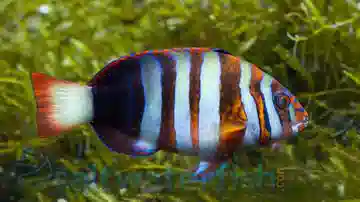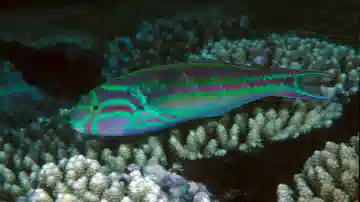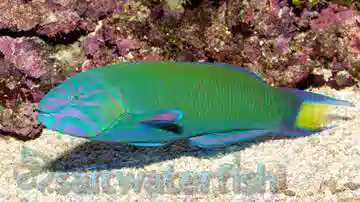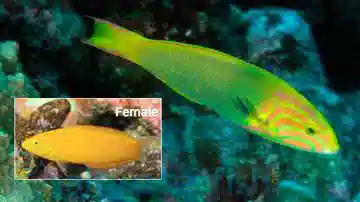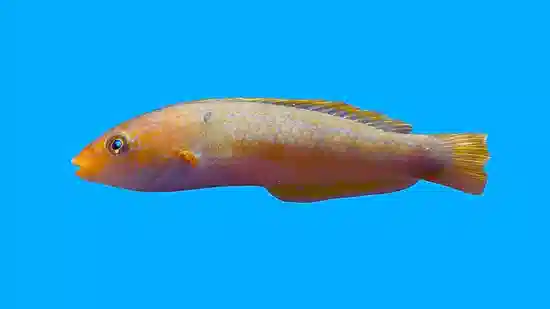Chameleon Wrasse
Halichoeres dispilus
(1 Reviews)
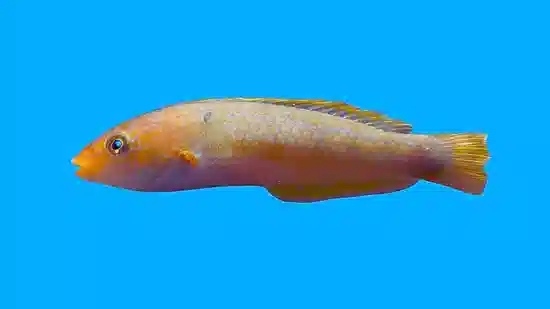
Chameleon Wrasse
Halichoeres dispilus
(1 Reviews)
{{ item.name }}
Size: {{ item.extra_field_3 }}
${{ getFormattedPrice(item.saleprice) }} ${{ getFormattedPrice(item.price) }}
To join the waiting list, click here
Free Shipping
With
$199.00
or more in Marine Life.
More details...
Chameleon Wrasse Care Facts
| Care Level: | Moderate |
|---|---|
| Temperament: | Peaceful |
| Diet: | Carnivore |
| Reef Safe: | No |
| Minimum Tank Size: | 75 Gallons |
| Max Size: | 6 inches |
Looking to add some vibrant color and activity to your saltwater aquarium? Consider the Chameleon Wrasse, also known as the Dispersed Wrasse. This lively fish is known for its ability to change colors and patterns, making for a captivating addition to any tank. However, there are some important things to keep in mind before adding one to your aquarium.To ensure the health and happiness of your Chameleon Wrasse, you'll need a tank that's at least 75 gallons, with plenty of hiding places and room to swim. They also require a varied diet of meaty foods including brine, mysis, krill, and other meaty saltwater foods. While they can be kept with other peaceful fish, they may become aggressive towards other wrasses or fish with a similar body shape, and are generally not recommended for reef tanks as they can nip at corals and target invertebrates.
The Chameleon Wrasse: Guide for Your Aquarium
The Chameleon Wrasse, also known by its scientific name Halichoeres hortulanus, is a colorful and intriguing marine fish species native to the Indo-Pacific region. It is renowned for its ability to change coloration, which it uses for communication, camouflage, and territorial displays. These wrasses typically inhabit coral reefs, lagoons, and rocky areas, where they forage for small invertebrates and crustaceans. With proper care and a well-established aquarium environment, Chameleon Wrasses can make a captivating addition to saltwater aquariums, delighting enthusiasts with their vibrant hues and dynamic behavior.
Chameleon Wrasse Habitat and Reef Compatibility
Native to the Indo-Pacific region, the Chameleon Wrasse (Halichoeres hortulanus) is commonly found in coral-rich areas, especially around reef slopes and lagoons. While they generally do not threaten corals or other invertebrates, caution should be exercised with small crustaceans, as they may be seen as potential prey.
Chameleon Wrasse Size and Lifespan
The Chameleon Wrasse typically grows to a maximum size of around 5-6 inches in captivity. They can live up to 5-7 years with proper care, providing long-term enjoyment for aquarists.
Chameleon Wrasse Diet in Captivity
In captivity, the Chameleon Wrasse should be fed a varied diet consisting of high-quality marine flake or pellet food supplemented with occasional offerings of frozen or live foods such as brine shrimp, mysis shrimp, and small crustaceans. Providing a diverse diet ensures their nutritional needs are met and helps mimic their natural feeding behavior.
Chameleon Wrasse Aquaculture and Availability
While wild-caught specimens were more common in the past, efforts in aquaculture have made Chameleon Wrasses increasingly available to hobbyists. At reputable suppliers like Saltwaterfish.com, aquacultured specimens may be offered, promoting sustainability and reducing the impact on wild populations.
Chameleon Wrasse Compatibility with Other Fish and Invertebrates
The Chameleon Wrasse is generally peaceful but may exhibit territorial behavior towards conspecifics or similar-shaped fish. They are best kept in larger aquariums with plenty of hiding spots and should be introduced to the tank after other fish have established territories. Compatible tank mates include peaceful species like Clownfish, Gobies, Dartfish, Blennies, and Fairy Wrasses.
Chameleon Wrasse Sexual Dimorphism and Coloration Changes
Juvenile Chameleon Wrasses exhibit a distinct checkerboard pattern, while adults develop vibrant blue and yellow coloration with a black spot near the base of the dorsal fin. Additionally, males may display brighter colors and elongated dorsal fin rays than females.
Chameleon Wrasse Temperament and Tank Requirements
The Chameleon Wrasse is generally peaceful and active swimmers, adding vitality to marine aquariums. A minimum tank size of 75 gallons is recommended to provide ample swimming space and accommodate their territorial tendencies. Adequate hiding spots and live rock arrangements should be provided to mimic their natural habitat.
Chameleon Wrasse Water Conditions
Maintaining stable water conditions is crucial for the health and well-being of Chameleon Wrasses. Recommended water parameters include:
- pH: 8.1-8.4
- Salinity: 1.023-1.025
- Water Temperature: 72-78°F
- Water Flow: Moderate to high flow is ideal, mimicking their natural reef habitat.
Other Common Names
In addition to the Chameleon Wrasse, Halichoeres hortulanus may also be referred to as the Checkerboard Razorfish or Hortulan Wrasse.
Why Choose Saltwaterfish.com?
Saltwaterfish.com offers a reliable source for aquarists seeking high-quality marine livestock. With a commitment to sustainable practices and a wide selection of aquacultured specimens, they provide peace of mind to hobbyists while supporting conservation efforts. By purchasing Chameleon Wrasses from Saltwaterfish.com, customers can enjoy vibrant and healthy specimens delivered straight to their doorstep, ensuring a seamless and satisfying aquarium experience.
Conclusion
In conclusion, the Chameleon Wrasse is a captivating addition to saltwater marine aquariums, offering aesthetic beauty and exciting behavior. With proper care and suitable tank mates, these fish can thrive in captivity, providing aquarists with years of enjoyment. For those looking to add this stunning species to their collection, Saltwaterfish.com is a reputable source, offering aquacultured specimens and a commitment to sustainability.
Reviewed by: Gary Sparks on May 27, 2024


